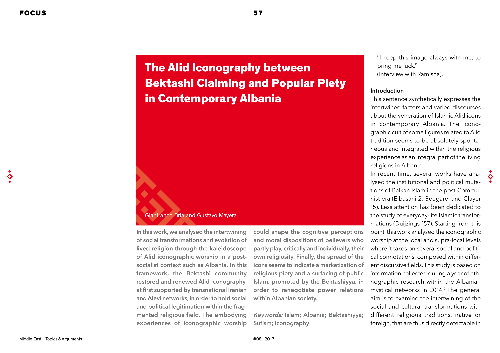The Alide Iconography between Theological Debate and Popular Piety in Contemporary Albania
In this work, we analysed the intertwining of social transformations and evolution of lived religion through the kaleidoscope of Alid iconographic worship in a postsocialist context such as Albania. In this framework, the Bektashi community restored and renewed Alid iconography, at first supported b...
Guardado en:
| Publicado en: | Middle East - Topics & Arguments |
|---|---|
| Autores principales: | , |
| Formato: | Artikel (Zeitschrift) |
| Lenguaje: | inglés |
| Publicado: |
Philipps-Universität Marburg
2017
|
| Materias: | |
| Acceso en línea: | Acceso en línea |
| Etiquetas: |
Sin Etiquetas, Sea el primero en etiquetar este registro!
|
| Sumario: | In this work, we analysed the intertwining of social transformations and evolution of lived religion through the kaleidoscope of Alid iconographic worship in a postsocialist context such as Albania. In this framework, the Bektashi community restored and renewed Alid iconography, at first supported by transnational Iranian and Alevi networks, in order to hold social and political legitimation within the fragmented religious field. The embodying experiences of iconographic worship could shape the cognitive perceptions and moral dispositions of believers who partly play, critically and individually, their own religiosity. Finally, the spread of the icons seems to indicate a marketization of religious piety and a surfacing of public Islam, promoted by the Bektashiyya, in order to renegotiate power relations within Albanian society. |
|---|---|
| DOI: | 10.17192/meta.2017.8.6080 |
